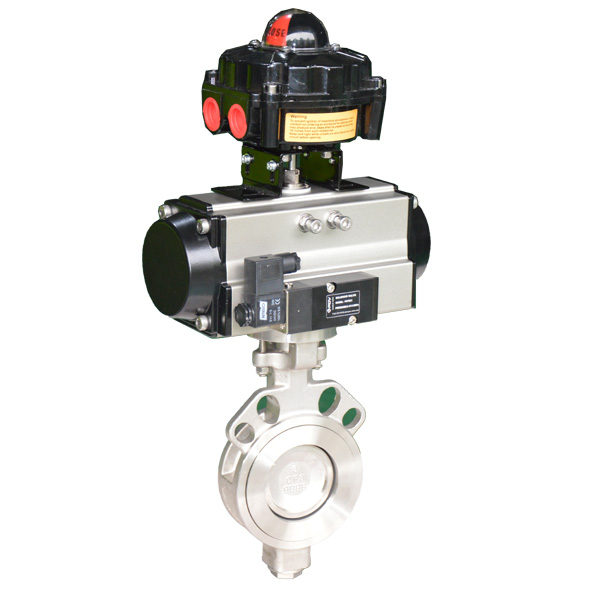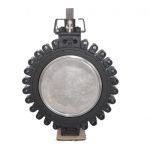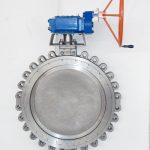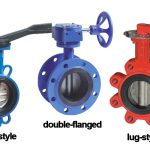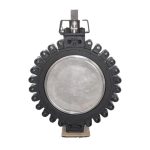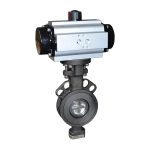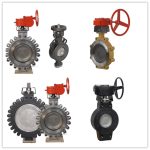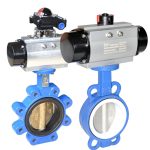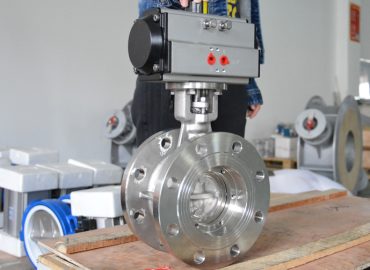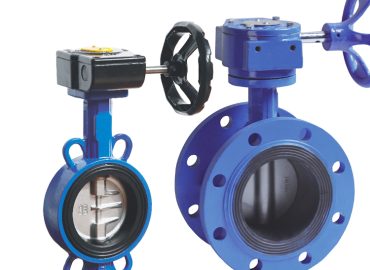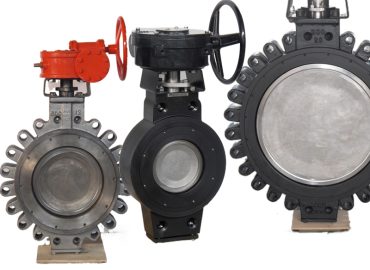Butterfly valve are an integral part of many industrial processes, playing a crucial role in regulating the flow of liquids and gases. They come in different types and sizes, each designed to meet specific needs and applications. Among these are the General Service and High-Performance butterfly valves, both commonly available in a 400mm size. This blog post seeks to provide a detailed comparative analysis between these two types of 400mm butterfly valves. We will delve into their design, operation, application, performance, reliability, and cost-effectiveness to help you make an informed decision when choosing between General Service and High-Performance butterfly valves for your specific industrial needs.
Introduction
Butterfly valve, commonly used in a variety of industrial applications, come in several types, each with its unique characteristics and capabilities. Among these are General Service and High-Performance butterfly valve, both available in the 400mm size. The General Service butterfly valve is typically designed for standard applications that do not require high pressure or temperature resistance. They are often used in water distribution, HVAC systems, and other general utility services, where they offer reliable performance and cost-effectiveness. These valves feature a simple but functional design, usually made from ductile iron, and utilize a rubber seat to provide a tight seal. On the other hand, High-Performance butterfly valve are engineered for more demanding applications where higher pressures and temperatures are involved. These valves are built with sturdier materials like carbon steel or stainless steel and use a resilient seat material, often metal, to withstand harsh conditions. They are commonly found in industries such as power generation, oil and gas, and chemical processing. While they may come at a higher initial cost than General Service valves, their robust construction and superior performance can lead to lower maintenance costs and longer service life, potentially offering better long-term value. Therefore, when choosing between a General Service and a High-Performance 400mm butterfly valve, it’s essential to consider not only the immediate application requirements but also the operational conditions, life-cycle costs, and long-term reliability.
Brief explanation of the purpose and importance of butterfly valves in industrial processes.
Butterfly valve play a pivotal role in numerous industrial processes due to their ability to regulate, direct, and control the flow of various mediums such as liquids, gases, and slurries. These versatile devices function by using a disc, which is pivoted in the center, to either allow the medium to pass through when it’s aligned with the flow or to block it when it’s turned perpendicular. The importance of butterfly valve in industrial settings cannot be overstated. They provide an efficient method for starting, stopping, and throttling flow, which is crucial in many operations. Their design allows them to handle large flow volumes with minimal space requirements, making them an economical choice for large-scale applications. Additionally, they offer excellent durability and reliability, reducing the need for frequent maintenance and replacements. From water treatment plants to oil refineries, HVAC systems to power generation facilities, butterfly valve are instrumental in ensuring smooth and efficient process operations.
Introduction to the two types of butterfly valve: General Service and High-Performance.
Butterfly valve are essential components in many industrial processes, with two primary types being General Service and High-Performance. General Service butterfly valve, as the name suggests, are designed for general applications where conditions are not particularly harsh. They are often used in systems handling water, air, and other non-corrosive fluids, typically at moderate pressures and temperatures. These valves are known for their cost-effectiveness and reliability in standard applications. On the contrary, High-Performance butterfly valve are designed for more demanding applications. They are built to withstand higher pressures, extreme temperatures, and corrosive environments, making them ideal for industries like power generation, oil and gas, and chemical processing. These valves are constructed from robust materials such as carbon steel or stainless steel, and their design often includes a metal seat for improved durability and sealing capabilities. While they may come with a higher upfront cost compared to General Service valves, their superior performance and longevity can provide better value over time, especially in challenging industrial settings.
Purpose of the blog: To provide a comparative analysis of General Service vs. High-Performance 400mm butterfly valve.
The purpose of this blog is to provide a comprehensive comparative analysis of two types of 400mm wafer butterfly valve: General Service and High-Performance. This comparison is aimed at helping decision-makers, engineers, and other interested parties in understanding the fundamental differences, advantages, and potential applications of these two types of valves. By delving into the key characteristics, operational efficiencies, cost implications, and suitability for different industrial environments of both General Service and High-Performance butterfly valve, this blog aims to serve as a valuable resource. The ultimate goal is to aid in making informed decisions when selecting the most suitable valve type for their specific needs, considering not only immediate application requirements but also long-term performance, durability, and return on investment.
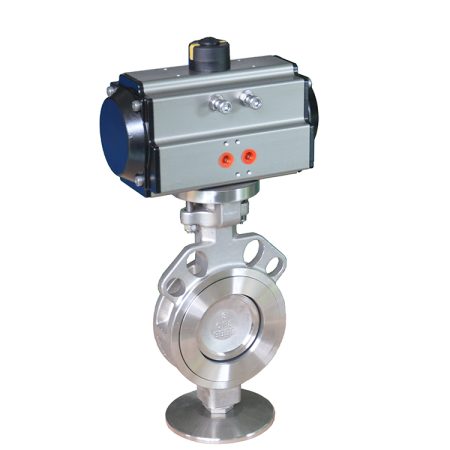
What is a Butterfly Valve?
A butterfly valve is a type of flow control device, typically used to regulate a fluid flowing through a section of pipe. The name ‘butterfly’ comes from the appearance of the central disc in the valve which, like wings on a butterfly, opens and closes to control fluid flow. This disc is mounted on a rotating shaft. When the butterfly valve is fully opened, the disc is rotated a quarter turn so that it allows an almost unrestricted passage of the fluid. When the disc is rotated a quarter turn to close the valve, it presents its broad side to the flow and blocks the passage. Butterfly valves are known for their quick shut off capabilities, hence they are used in many applications where fast flow interruption is needed. They are also lighter in weight, require less support, and are significantly smaller than other types of valves. Butterfly valves can be used with many different types of media, including water, air, chemicals, and even semi-liquid substances. They are commonly used in water supply, wastewater treatment, fire protection, and gas supply, among other industrial applications. Their simplicity, ease of use, and relatively low cost make them an essential tool in any flow control system.
Detailed explanation of what a butterfly valve is and how it works.
A butterfly valve is a rotary valve that controls the flow of a fluid. The main component is a disk that is mounted on a rotating shaft inside the valve body. When the valve is fully open, the disk rotates to align with the direction of the flow, allowing fluid to pass through the valve body with minimal obstruction. As the valve closes, the disk rotates by 90 degrees, presenting its broad surface to the flow and blocking the passage of fluid. This simple operation makes butterfly valves very efficient for flow control and isolation.
The operation of the butterfly valve can be manual, using a handwheel connected to the stem of the valve, or automated, using an actuator. Actuators can be pneumatic, hydraulic, or electric, and they allow the valve to be remotely controlled, which can be crucial in large industrial installations.
Butterfly valves are widely used because of their simplicity, reliability, and low cost. They are typically used in applications where a tight shut-off is not required, such as water distribution, cooling systems, and air handling systems. However, with the use of appropriate materials and designs,marine butterfly valves can also handle more demanding applications, including high pressures, high temperatures, and corrosive fluids.
Discussion on the different components of a lug butterfly valve such as the body, disc, stem, and seat.
A butterfly valve consists of several key components that work together to control the flow of a fluid. The body of the valve is the outer casing that holds all the other components. It’s typically made from durable materials like cast iron, stainless steel, or plastic, depending on the application. Inside the body is the disc, which is the central part of the valve that rotates to open or close the flow path. It’s often designed in a slim, wafer-like shape to minimize disruption to the flow when the valve is open.
The stem is a rod that connects the disc to the actuator or handle outside the valve body. When the actuator or handle is turned, it rotates the stem, which in turn rotates the disc. The stem can be either a one-piece design, where the disc is mounted directly on the stem, or a two-piece (split-stem) design, where the disc is sandwiched between two stem pieces.
The seat of the butterfly valve is a sealing element that ensures a tight closure when the valve is shut. It’s usually made of resilient materials like rubber or high-performance plastics. The seat can be bonded to the body (seat liner) or mounted on the disc (cartridge seat). The design and material of the seat are critical factors in determining the pressure and temperature limits of the valve, as well as its resistance to wear and chemical attack.
-450x450.jpg)
Explanation on the role of the size of the valve, specifically the 400mm butterfly valve.
The size of a butterfly valve, including a 400mm butterfly valve, is typically determined by the diameter of the pipe in which it will be installed. The 400mm dimension refers to the nominal diameter of the valve and pipe. This size of valve is designed to control a substantial volume of fluid flow, making it suitable for large industrial applications or significant infrastructure systems like water treatment facilities. The larger the valve, the more fluid it can manage at once, but it also requires more force to operate due to the increased fluid pressure. It’s important to note that the size of the valve must be appropriate for the system in which it’s being used. Too small a valve could restrict flow and cause a drop in system efficiency, while too large a valve could cause unnecessary expense and complexity. Therefore, a 400mm butterfly valve would be an optimal choice for a system that requires the handling of large volumes of fluid efficiently and effectively.
General Service Butterfly Valve
General service butterfly valves are versatile and efficient devices used in a variety of fluid control applications. They are typically employed in systems where there is a need for regulating or isolating the flow of a fluid, be it gas or liquid. These valves are popular due to their simplicity, durability, and cost-effectiveness. They consist of a disc attached to a rotating stem, which when turned, allows the disc to pivot within the valve body, thereby opening or closing the valve. The design of these valves is such that they can provide optimal control over fluid flow with minimal disruption when fully open, and effective isolation when closed.
The materials used in the construction of general service butterfly valves often include cast iron, stainless steel, or plastic for the body, and resilient materials like rubber or high-performance plastics for the seat. The choice of materials depends on the specific application and the nature of the fluid being handled. For instance, stainless steel might be used in applications involving corrosive fluids or high temperatures, while plastic might be preferred for less demanding applications.
One of the defining features of general service butterfly valves is their ease of operation. They can be operated manually using a handwheel or lever, or automatically using an actuator. Actuators can be pneumatic, hydraulic, or electric, allowing for remote operation and control, which can be crucial in large-scale industrial installations.
While general service butterfly valves are not typically used in applications requiring a tight shut-off, their design and materials can be adapted for more demanding scenarios. For example, with the use of appropriate seat materials and designs, these valves can handle higher pressures, temperatures, and even corrosive fluids. In conclusion, general service butterfly valves are a reliable and efficient choice for a wide range of fluid control applications, offering a balance of performance, versatility, and cost-effectiveness.
Detailed definition and description of General Service butterfly valve.
General Service Butterfly Valves are a type of quarter-turn valve that regulate or isolate the flow of liquids, gases, and slurries within a system. They get their name from the disc inside the valve body, which rotates like a butterfly’s wings to control fluid flow. This disc is mounted on a rotating stem, which turns to pivot the disc either parallel or perpendicular to the flow. The design of these valves is straightforward yet efficient, providing minimal disruption to the flow when fully open and effective isolation when closed.
Structurally, General Service Butterfly Valves are made up of a circular body, a disc, a stem, and a seat. The body, typically constructed from materials like cast iron, stainless steel, or plastic, houses all the components. The disc, located centrally, rotates to manage the flow. The stem, which connects the disc to an external actuator or handle, rotates the disc as it’s turned. Finally, the seat provides a tight seal when the valve is closed, preventing leaks.
These valves are widely used across various industries due to their durability, cost-effectiveness, and ease of operation. They can be operated manually with a handwheel or lever or automatically using an actuator. While they’re not usually designed for high-pressure applications or environments requiring a tight shut-off, modifications in design and materials can make them suitable for more demanding situations. Overall, General Service Butterfly Valices offer a reliable and versatile solution for fluid flow management.

Explanation of the design and operation of General Service butterfly valve.
General Service Butterfly Valves are designed with a simple yet effective mechanism for regulating or isolating fluid flow in various systems. The primary components of the valve include the body, disc, stem, and seat. The valve body, typically made from durable materials like cast iron, stainless steel, or plastic, houses the other components. Inside the body, a disc is mounted on a rotating stem. As the stem rotates, so does the disc, pivoting either parallel or perpendicular to the fluid flow.
The operation of these valves is based on a quarter-turn design. When the stem is turned a quarter of a circle (90 degrees), it moves the disc from a fully open position (parallel to the flow) to a fully closed position (perpendicular to the flow). In the open position, the disc aligns with the fluid flow, offering minimal resistance and disruption. In the closed position, the disc blocks the passage, stopping the fluid flow. This rotation can be performed manually via a handwheel or lever, or automatically using an actuator.
The seat of the valve plays a crucial role in ensuring a tight seal when the valve is closed, preventing any leaks. Depending on the specific application requirements, different materials can be used for the seat to handle varying pressures, temperatures, and fluid types. Overall, the design and operation of General Service Butterfly Valves offer efficiency, reliability, and versatility, making them suitable for a wide range of applications.
Discussion on the common applications and industries that use General Service butterfly valve.
General Service Butterfly Valices are widely used across a range of industries due to their versatility, durability, and cost-effectiveness. In the water and wastewater industry, these valves are commonly used for controlling the flow of water in treatment plants and distribution systems. They are also prevalent in the oil and gas industry where they manage the flow of oil, gas, and other petroleum products in pipelines and processing facilities.
In the chemical industry, General Service Butterfly Valices are employed to handle a variety of corrosive and non-corrosive fluids. The food and beverage industry uses these valves in processing systems for controlling the flow of liquid ingredients, while in the HVAC industry, they are used for regulating the flow of chilled or heated water in cooling and heating systems.
Power plants also use General Service Butterfly Valices for a variety of applications, including cooling water systems, feed water systems, and turbine bypass systems. They are also used in fire protection systems for controlling the flow of fire suppression materials. Overall, the broad applicability of these valves comes from their efficient design, ease of operation, and adaptability to different materials and conditions.
Pros and Cons of General Service butterfly valve.
General Service Butterfly Valves come with several advantages and a few disadvantages. Starting with the pros, these valves are known for their simplicity and ease of operation. Their quarter-turn operation allows for quick and efficient control of fluid flow, which can be beneficial in emergency shutdown situations. They are also compact and lightweight compared to other valve types, making them easier to install and maintain.
Butterfly valves are versatile and can handle a wide range of temperatures and pressures, making them suitable for various applications across different industries. They are cost-effective, both in terms of initial investment and long-term maintenance costs, as they have fewer moving parts and require less material to manufacture.
On the downside, while General Service Butterfly Valves are suitable for many applications, they may not be ideal for high-pressure systems or those requiring a tight shutoff, as they might allow a small amount of leakage when closed. Also, the disc that controls the flow can create a pressure drop in the system even when fully open, which may impact the efficiency of the system. Lastly, the durability of these valves can be affected by the type of fluid being controlled; certain corrosive or abrasive fluids can wear down the disc and seat over time, leading to potential leaks or failure. Therefore, careful consideration is needed when selecting butterfly valves for specific applications.
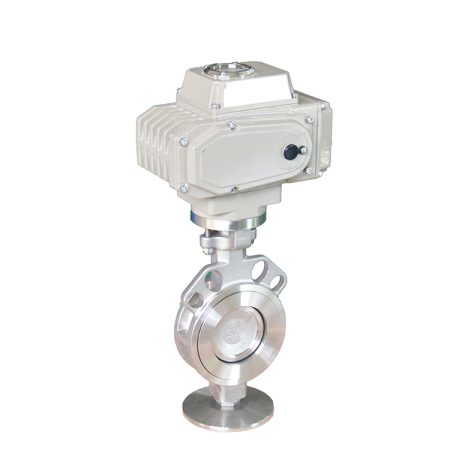
High-Performance Butterfly Valve
High-Performance Butterfly Valves are a specialized type of butterfly valve designed to handle higher pressures and temperatures than standard butterfly valves. They are often used in industrial applications where extreme conditions are present. The design of these valves includes a double offset or even triple offset disc-stem configuration, which reduces friction between the disc and seat during operation. This unique design allows the valve to achieve a tighter seal and prolongs the lifespan of the valve, reducing maintenance requirements.
The materials used in High-Performance Butterfly Valves are typically more robust to withstand harsh conditions, often including metal seats and seals, and bodies made from stainless steel or other high-strength alloys. These valves can be actuated manually or automatically and are available with a range of actuator options to suit different operational needs.
In terms of performance, these valves provide excellent flow control and minimal pressure drop, even under high-pressure scenarios. Despite their enhanced capabilities, they maintain the compact and lightweight design characteristic of butterfly valves, making them an efficient and effective choice for demanding industrial applications. However, they tend to be more expensive than general service butterfly valves due to their advanced design and higher-grade materials.
Detailed definition and description of High-Performance butterfly valve.
High-Performance Butterfly Valves are a type of quarter-turn rotary valve that is specifically designed to handle high pressure and temperature applications. This valve is distinguished by its double offset or triple offset stem-disc configuration, which sets the disc off-center from the valve body and the line of the seal to minimize wear and tear and improve sealing capabilities.
When the valve is closed, the disc makes contact with the seal at the last moment of closure, reducing friction and thereby extending the lifespan of the seal. The materials used in these valves generally include durable metals such as stainless steel or other high-strength alloys, capable of withstanding extreme conditions.
The High-Performance Butterfly Valve offers excellent throttling performance and minimal pressure drop due to its streamlined disc design, making it an efficient choice for flow control in various industrial applications. It can be actuated manually or automatically, with a range of actuator options available to meet different operational requirements.
While this type of butterfly valve provides enhanced performance and durability, it tends to be more expensive than general service butterfly valves due to its advanced design and superior materials. However, its long-term reliability and efficiency often justify the initial investment.
Explanation of the design and operation of High-Performance butterfly valve.
High-Performance Butterfly Valves are specifically engineered to handle high-pressure and high-temperature applications. They feature a unique double offset design, where the stem is off-center to or behind the disc, and the disc is offset from the seat center, as explained in an article on Valvemagazine.com. This ingenious configuration minimizes friction between the disc and the seal during operation, enhancing the valve’s durability and sealing capabilities.
The operation of these valves can be manual or automatic, using handles, gears, or actuators. The disc moves to control fluid flow in response to the actuation mechanism. Interestingly, these valves use the pressure in the pipeline to increase the seal between the seat and the disc edge, thereby achieving a tighter shutoff.
The seat design of these valves even allows for operation in vacuum application, providing versatility in usage. Overall, the High-Performance Butterfly Valve’s design and operation offer efficiency, reliability, and extended service life, albeit at a higher cost than standard butterfly valves.
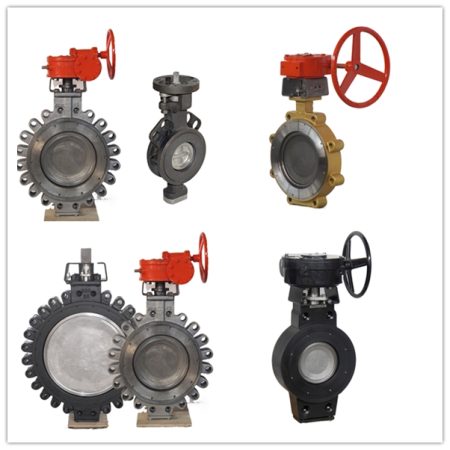
Discussion on the common applications and industries that use High-Performance butterfly valve.
High-Performance Butterfly Valves are widely used across various industries due to their ability to handle high pressures and temperatures effectively. In the oil and gas industry, they are often employed in process control applications, pipeline transportation, and refining processes where robust flow control is required.
In the chemical industry, these valves are used for controlling the flow of aggressive and corrosive substances due to their durable materials and tight sealing capabilities. They’re also common in power generation plants, particularly in cooling systems, boiler feed water systems, and steam isolation applications.
The water and wastewater treatment sector uses High-Performance Butterfly Valves for a variety of applications, including water distribution, sewage treatment, and slurry control. Their corrosion-resistant properties make them suitable for these environments.
Food and beverage industries utilize these valves for sanitary applications, as they can be designed with materials that meet stringent hygiene standards. The pharmaceutical industry also uses these valves in their manufacturing processes, where precise flow control and high hygiene standards are paramount.
In HVAC systems, these valves are often used to control the flow of hot and cold fluids. In all these applications, High-Performance Butterfly Valves are favored for their durability, efficiency, and ability to provide a reliable seal even under extreme conditions.
Pros and Cons of High-Performance butterfly valve.
High-Performance Butterfly Valves come with several advantages. They are known for their robustness and ability to handle high-pressure and high-temperature applications, making them suitable for demanding industrial settings. Their unique double offset design ensures minimal wear on the seal, extending the valve’s lifespan and reducing maintenance requirements. Moreover, due to their streamlined disc design, they provide excellent throttling capabilities with low pressure drops, ensuring efficient flow control.
However, High-Performance Butterfly Valves also have some drawbacks. One of the main disadvantages is their cost. These valves are typically more expensive than standard butterfly valves due to their advanced design and use of high-quality materials. While this initial investment may be higher, it often pays off in the long run due to the valve’s durability and efficiency. Another potential downside is that while these valves are good for isolation and throttling applications, they might not be suitable for certain specific services such as slurry or abrasive fluid applications, as these can cause premature wear on the disc and seat. Lastly, while they handle high pressures and temperatures, there are still limits to their capabilities, and they may not be suitable for extremely high-pressure or temperature applications.
Comparative Analysis: General Service vs. High-Performance Butterfly Valve
General Service Butterfly Valves and High-Performance Butterfly Valves both serve the purpose of regulating fluid flow in pipelines, but they vary significantly in their design, performance, and applications.
General Service Butterfly Valves, often referred to as standard or resilient-seated butterfly valves, typically consist of a disc that pivots on a central axis to control flow. They are lightweight, compact, and relatively inexpensive, making them popular for moderate pressure and temperature applications. These valves are ideal for water, air, and other non-aggressive media, but may struggle with corrosive or high-temperature fluids due to their material limitations.
High-Performance Butterfly Valves, on the other hand, feature a double offset design where the stem is off-center from the disc, and the disc is offset from the seat center. This unique design minimizes friction between the disc and the seal, enhancing the valve’s durability and sealing capabilities. They are built to handle high-pressure and high-temperature applications, making them suitable for more demanding industrial environments such as oil and gas, chemical, and power generation industries.
While High-Performance Butterfly Valves offer superior performance, they come at a higher cost than General Service Butterfly Valves. This is due to their advanced design, the use of high-quality materials, and the increased manufacturing complexity. However, this initial investment often pays off in the long run due to the valve’s durability, efficiency, and extended service life.
In conclusion, while General Service Butterfly Valves are a cost-effective solution for moderate applications, High-Performance Butterfly Valves are the preferred choice for more challenging applications due to their superior performance characteristics. The choice between the two ultimately depends on the specific requirements of the application, including factors like fluid type, pressure, temperature, and budget.
Comparative analysis based on design and operation.
When comparing General Service Butterfly Valves and High-Performance Butterfly Valves based on their design and operation, significant differences emerge.
General Service Butterfly Valves are designed with a simple, direct disc-to-shaft connection, which allows for straightforward operation – the disc rotates around a central axis to either allow or stop fluid flow. This simplicity makes them easy to install and operate, but it also means they may not provide as tight a seal as other valve types, which can lead to potential leakage.
High-Performance Butterfly Valves, on the other hand, feature a more complex double offset design. The stem is off-center from the disc, and the disc is offset from the seat center. This design significantly reduces the friction between the sealing surfaces during operation, which results in less wear and tear and a longer lifespan. It also allows these valves to provide a tighter seal, reducing the risk of leakage. However, this advanced design can make High-Performance Butterfly Valves a bit more challenging to install and operate compared to their general service counterparts.
In summary, while General Service Butterfly Valves offer simplicity in design and operation, High-Performance Butterfly Valves provide superior sealing capabilities and durability due to their advanced design. The choice between the two will largely depend on the specific requirements of the application.
Comparative analysis based on application and industry usage.
General Service Butterfly Valves and High-Performance Butterfly Valves find their applications in different industries based on their unique attributes and capabilities.
General Service Butterfly Valves are commonly used in applications where the need for flow regulation is moderate. Due to their simplicity, cost-effectiveness, and ease of operation, these valves are popular in industries such as water treatment, wastewater management, and HVAC systems. They are suitable for handling non-aggressive media like air, water, and certain mild chemicals. However, their usage might be limited in industries that deal with corrosive or high-temperature fluids due to their material limitations.
High-Performance Butterfly Valves, on the other hand, are designed to handle more demanding applications. They feature a robust design that can withstand high pressures and temperatures, making them ideal for industries like oil and gas, chemical processing, power generation, and other heavy-duty industrial applications. Their superior sealing capabilities make them a good choice for applications that require tight shut-off, such as fuel handling systems or process control applications.
In summary, while General Service Butterfly Valves are a practical choice for moderate applications in industries like water treatment and HVAC, High-Performance Butterfly Valves are more suited to heavy-duty industrial applications due to their high durability and performance under demanding conditions. The choice between these two types of valves ultimately depends on the specific requirements of the industry and application.
Comparative analysis based on performance and reliability.
When comparing General Service Butterfly Valves and High Performance Valve based on performance and reliability, the latter typically outshines the former.
General Service Butterfly Valves, owing to their simple design and operation, perform well in moderate pressure and temperature applications. They offer reliable service in managing flow control of non-aggressive media such as air and water. However, these valves may not provide the same level of performance or reliability when exposed to corrosive or high-temperature fluids due to their material limitations.
On the other hand, High-Performance Butterfly Valves are designed to excel under demanding conditions. Their double offset design reduces friction between the sealing surfaces, enhancing the durability and extending the lifespan of the valve. This design also allows for a tighter seal, improving the valve’s performance by reducing potential leakage. High-Performance Butterfly Valves can reliably handle high-pressure and high-temperature applications, making them a robust choice for challenging industrial settings.
In conclusion, while General Service Butterfly Valves offer satisfactory performance and reliability for moderate applications, High-Performance Butterfly Valves provide superior performance and reliability, particularly in high-pressure, high-temperature environments. The choice between the two would depend on the specific performance and reliability requirements of the application.
Comparative analysis based on cost-effectiveness.
When comparing General Service Butterfly Valve and High-Performance Butterfly Valve based on cost-effectiveness, both have their merits depending on the specific application.
General Service Butterfly Valve, with their simple design and straightforward operation, are typically less expensive to purchase, install, and maintain. They are a cost-effective solution for applications requiring moderate flow control of non-aggressive fluids. However, their potential for leakage and limited durability under high-pressure or high-temperature conditions might lead to higher long-term costs due to the need for more frequent replacements or repairs.
On the other hand, High-Performance Butterfly Valve, although more expensive upfront due to their advanced design, can prove to be more cost-effective in the long run. Their double offset design reduces wear and tear, extending the lifespan of the valve, and their tighter sealing capabilities minimize leakage, reducing wastage and potential damage to other system components. These factors can result in lower maintenance and replacement costs over time, particularly in demanding industrial applications.
In conclusion, while General Service Butterfly Valives may be more cost-effective for moderate applications due to their lower initial costs, High-Performance Butterfly Valve could offer better cost-effectiveness in the long term, especially in high-pressure and high-temperature environments, due to their superior performance and durability. The choice between the two will depend on the specific cost considerations and requirements of the application.

Conclusion
In conclusion, the choice between General Service and High-Performance Butterfly Valve is not a one-size-fits-all answer but depends on a multitude of factors such as application, industry usage, performance, reliability, and cost-effectiveness. This comparative analysis sheds light on these different aspects to help guide your decision-making process.
When it comes to applications and industry usage, General Service Butterfly Valve are particularly suited for industries that deal with moderate pressure and temperature environments, such as water treatment and HVAC systems. They offer a cost-effective solution for controlling the flow of non-aggressive media like air and water.
However, when the operational environment becomes more demanding—high pressures, high temperatures, corrosive fluids—the High-Performance Butterfly Valve come into their own. With their robust design and superior sealing capabilities, they excel in industries like oil and gas, chemical processing, and power generation. They are designed to handle tough conditions and provide reliable service under challenging circumstances.
In terms of performance and reliability, High-Performance Butterfly Valve outshine General Service Butterfly Valve. The double offset design enhances durability, extends the lifespan of the valve, and allows for a tighter seal, thus improving performance by reducing potential leakage. This makes them a robust choice for challenging industrial settings where reliability and high performance are critical.
When we talk about cost-effectiveness, both types of valves have their merits. General Service Butterfly Valves=, with their lower initial costs, are a cost-effective solution for moderate applications. However, the potential for increased maintenance or replacement costs due to their limited durability under harsh conditions should be considered.
High-Performance Butterfly Valves=, on the other hand, might be more expensive upfront but could prove more cost-effective in the long run. Their superior performance and durability, especially under high-pressure and high-temperature conditions, can lead to lower maintenance and replacement costs over time.
Ultimately, the choice between a General Service and a High-Performance Butterfly Valve for your 400mm application will depend on the specific requirements of your project. It’s crucial to carefully consider all aspects—application, industry usage, performance, reliability, and cost-effectiveness—to ensure that you choose the valve that best fits your needs.
Remember, the right valve can significantly impact the efficiency and longevity of your system. Therefore, making a well-informed decision is not only a matter of cost but also a matter of operational success and system durability.
Summary of the main points discussed in the article.
In this article, we conducted a comparative analysis of General Service and High-Performance Butterfly Valve, particularly focusing on 400mm applications. We delved into their appropriate industry usage and applications, with the General Service Butterfly Valve being ideal for moderate environments and the High-Performance Butterfly Valve excelling in demanding conditions. Performance and reliability were also brought to light, where High-Performance valves showcased superior durability and sealing capabilities. In terms of cost-effectiveness, both have their advantages: General Service valves are more affordable upfront, while High-Performance valves, although expensive initially, can prove to be more economical over time due to their robustness and longevity. The article concluded by emphasizing that the choice between the two types depends on the specific requirements of your project, underscoring the importance of making a well-informed decision to ensure operational success and system durability.
Final thoughts and recommendations for choosing between General Service and High-Performance butterfly valve.
As we wrap up this discussion, it’s evident that both General Service and High-Performance Butterfly Valve have their unique strengths and are suited for different applications. Your choice should be guided by your specific project requirements, industry standards, and cost considerations. If you’re dealing with moderate conditions and non-aggressive fluids, General Service Butterfly Valve could be a cost-effective solution. However, if your operations involve high pressures, high temperatures, or corrosive fluids, investing in High-Performance Butterfly Valve would be a prudent decision despite their higher initial cost. Their superior performance, durability, and reliability can lead to significant savings in the long run. It’s always recommended to consult with an expert or a trusted valve supplier to help you make the most informed choice. By considering all these factors, you can ensure you select the right butterfly valve that will deliver optimal performance, longevity, and cost-effectiveness for your specific application.


